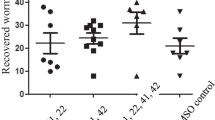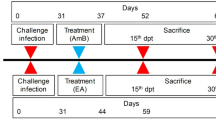Abstract
Filarial parasites like Brugia pahangi and Brugia malayi can infect dogs. Adults of Brugia genus resides in the lymphatic system and microfilariae, in blood. There are increasing reports of detection of B. malayi microfilariae in dogs. A study was undertaken to compare the efficacy of repeated oral dosing of ivermectin (IVT) and diethylcarbamazine (DEC), individually and in combination against naturally infected B. malayi microfilariae in dogs. The species of the microfilariae was confirmed by acid phosphatase staining and polymerase chain reaction. The three treatment groups were 200 mcg/kg body weight IVT daily for 14 days (I), 6.6 mg/kg body weight DEC daily for 14 days (II) and IVT and DEC together in the same dose for a period of 5 days (III). Microfilarial status of the peripheral blood was assessed on the 0th, 7th, 14th and 21st day. Haematological parameters were measured on day zero and on the 21st day. Though, all the three treatment groups showed a reduction in the microfilarial concentration through the study period, complete absence of detectable microfilaremia was not noticed in any of the three groups by 21st day. Among the haematological parameters, statistically significant difference was observed in the post-treatment means of haemoglobin levels of group III when compared with group II. Since group III regime (IVT + DEC) was shorter and just as effective as the longer ones, it is considered superior to the other two.

Similar content being viewed by others
References
Ambily VR (2009) Clinico-therapeutic studies on canine microfilariosis. M.V.Sc. thesis, Kerala Agricultural University, Thrissur
Ambily VR, Pillai UN, Arun S, Pramod S, Jayakumar KM (2011) Detection of human filarial parasite B. malayi in dogs by histochemical staining and molecular techniques. Vet Parasitol 181:210–214
Chalifoux L, Hunt RD (1971) Histochemical differentiation of Dirofilaria immitis and Dipetalonema reconditum. J Am Vet Med Assoc 158(5):601–605
Chansiri G, Khawsak P, Phantana S, Sarataphan N, Chansiri K (2005) The efficacy of a single-oral-dose administration of ivermectin and diethylcarbamazine on the treatment of feline Brugia malayi. Mol Cell Probes 16:129–135
Chirayath D (2013) Molecular characterization and therapeutic management of microfilariosis in dogs. Ph.D. thesis, Kerala Veterinary and Animal Sciences University, Pookode
Chirayath D, Alex PC, Usha NP (2015) Microscopic characteristics of canine filariasis in Thrissur District of Kerala. Indian Vet J 92:81–82
Chirayath D, Alex PC, Usha NP, George S, Ajithkumar S, Panicker VP (2017a) Identification of Brugia malayi in dogs in Kerala, India. Trop Biomed 34:804–814
Chirayath D, Alex PC, Usha NP (2017b) Immunoblotting analysis of canine B, malayi microfilarial antigens. Trop Biomed 34:815–821
Fernando SD, Rodrigo C, Rajapakse S (2010) Current evidence on the use of antifilarial agents in the management of bancroftian filariasis. J Trop Med 2011:175941
Hashem M, Badawy A (2008) Hematological and biochemical studies on filariasis of dogs. Internet J Vet Med 4(2):1–7
Murthy PK, Srivastava K, Murthy PSR (2004) Responses of Brugia malayi—Indian leaf monkey (Presbytis entellus), a non-human primate model of filariasis, to diethylcarbamazine, ivermectin and CDRI compound 82–437. Curr Sci 86(3):432–439
Phantana S, Sarataphan N, Chansiri G, Chansiri K (2002) Microfilaricidal efficacy of ivermectin on zoonotic Brugia malayi in naturally infected cats. J Trop Med Parasitol 25(25):11–16
Reddy G, Vengatesvarlou N, Das PK, Vanamail P, Vijayan AP, Kala S, Pani SP (2000) Tolerability and efficacy of single-dose diethyl carbamazine (DEC) or ivermectin in the clearance of Wuchereria bancrofti microfilaraemia in Pondicherry, south India. Trop Med Int Health 5(11):779–785
Stolk WA, Oortmarssen GJV, Pani SP, De Vlas SJ, Subramanian S, Das PK, Habbema JDF (2005) Effects of ivermectin and diethylcarbamazine on microfilariae and overall microfilaria production in bancroftian filariasis. Am J Trop Med Hyg 73(5):881–887
Suma TK (2013) Indian scenario of elimination of lymphatic filariasis. Medicine update. Asso Physicians India, Kolkata, pp 6–9
Taweethavonsawat P, Chungpivat S (2013) Successful Treatment of Brugia pahangi in naturally infected cats with ivermectin. Korean J Parasitol 51(6):759
Thomas J (2016) Clinical investigation on oedema of limbs in dogs. M.V.Sc thesis, Kerala Veterinary and Animal Sciences University, Pookode
Xie H, Bain O, Williams SA (1994) Molecular phylogenetic studies on Brugia filariae using Hha I repeat sequences. Parasite 1(3):255–260
Acknowledgements
The present paper is a part of MVSc thesis submitted to the Kerala Veterinary and Animal Sciences University and the authors are thankful to the University for the Facilities and grant rendered for the research.
Author information
Authors and Affiliations
Contributions
Poojary Vineeta Sadarama—MVSc scholar performed the research. Deepa Chirayath—Major guide for the MVSc Research who formulated the research work and gave instructions in performing the research and helped in preparing the manuscript. Usha Narayana Pillai—Minor guide for the MVSc research and Head of the Department who provided all guidance for the research. Bindu Lakshmanan—Minor Guide for the MVSc Research and guided for ELISA standardization.
Corresponding author
Ethics declarations
Ethical statement
There is no separate funding for this research project. The project is formulated following the guidelines of Institutional Animal Ethics Committee and got approval from faculty Research Committee with code number Ad/9/96/MVM/2015/CM. It is certified that all biomaterials required for the research were collected and the treatments were assigned, with prior written consent from the owners of the animals. There is no conflict of interest for the research findings. The article is a part of thesis submitted to Kerala Veterinary and Animal Sciences and submitted with consent from all authors.
Additional information
Publisher's Note
Springer Nature remains neutral with regard to jurisdictional claims in published maps and institutional affiliations.
Rights and permissions
About this article
Cite this article
Sadarama, P.V., Chirayath, D., Pillai, U.N. et al. Comparison of efficacy of ivermectin and diethylcarbamazine against naturally infected Brugia malayi microfilaria in dogs. J Parasit Dis 43, 554–559 (2019). https://doi.org/10.1007/s12639-019-01126-2
Received:
Accepted:
Published:
Issue Date:
DOI: https://doi.org/10.1007/s12639-019-01126-2




